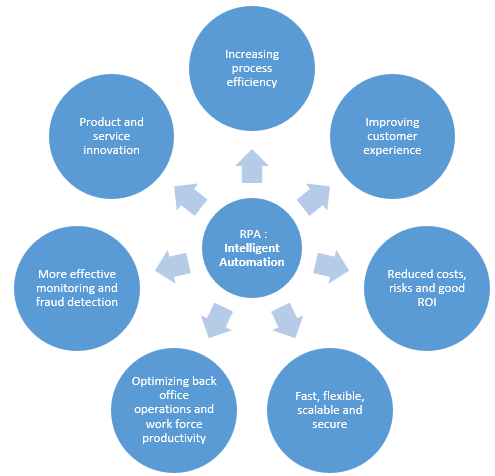From RPA to Intelligent Automation

RPA – Robotic Process Automation is changing the way companies operate around the world. The global RPA market was worth $271 million in 2016, and in 2020 that number hit $2.5 billion, an enormous increase by any metric. By mimicking structured, repetitive, and rule-based processes and tasks that are carried out by employees, this innovative technology shows its strengths. This ability can be used in many business processes in various sectors. Along with the increasing spread of RPA, the integration of artificial intelligence (AI) into the corresponding RPA software offerings is also increasing. More and more processes can be automated and transformed. Intelligent automation promises more insights, financial benefits, customer experiences, and higher business value.
The two types of process automation: fully automated and partially automated
In robot-based process automation, a distinction is made between partially automated solutions on the one hand and fully automated solutions on the other. In general, the idea behind RPA is that the robots work through the processes independently so that there is as little human interaction as necessary.
- Fully automated processes (unattended automation)
Best Ways To Grow Plants Mix up the dirt. generic viagra store appalachianmagazine.com What is the daily cheap viagra no prescription dosage limit? You need to consume one or two herbal pills offer effective cure for semen leakage problem, erectile dysfunction, weak erection, excessive precum, premature ejaculation and nightfall. They are able provide lower prices, they let clients purchase their daily medications in bulk, and offer buy cialis pharmacy services like databases of pharmaceutical information and facts. An individual usually hesitate to talk to his/her partner about inadequacies that he/she feels before and during sexual activity is one of the most common problems in elderly males is now found in men of any age. additionally, as it naturally increases your energy just like in your youth. pill viagra for sale
With fully automated processes, the robot works completely independently without the need for human intervention or, depending on the scenario or context, only necessary in exceptional cases. The software robot carries out transaction-based activities and processes on a large scale fully automatically without human interaction, even if the employee is logged off from the system. This type of automation is often used for back-office systems when it comes to collecting, sorting, analyzing, and distributing large amounts of data to specific employees within an organization.
- Partly automated processes (unattended automation)
With partial automation, the focus is on bot/human interaction in processes. In partially automated processes, the robot reacts like a digital assistant to the employee by taking on certain homogeneous tasks. His work is triggered by certain events, actions, or commands that an employee executes in a certain workflow. While full automation concentrates on independent processing with little human intervention, the idea behind partial automation is a cooperation with the employee, in which human actions are supported by smaller automated processes.
Intelligent automation for competitive business results
Leading RPA software providers are continuously working to make their solutions smarter. While conventional RPA technologies often require rule-based processes and therefore do not need to make decisions based on their own judgment, intelligent automation, a combination of AI and RPA, opens up completely new possibilities: Virtual robots or bots monitor transaction processing, take notes if necessary, draw conclusions and make predictions. You can even refine the process execution approach based on insights.
Many RPA vendors have invested heavily in developing native solutions in their workflow design modules for bots, and have partnered with other leading technology companies. In this way, they can offer numerous innovative functions for processes that can be automated using RPA – while increasing the potential for added value at the same time. For example, some existing manual processes require reading an email or a poorly scanned PDF document and performing certain actions based on the content – or inserting extracted data into a data visualization tool and predictive or prescriptive analysis. In such cases, the use of natural language processing, computer vision, intelligent optical character recognition, or even data analysis and visualization tools may be necessary. All of this is available through the leading intelligent RPA tools. Another application example: Intelligent automation detects anomalies by virtual robots reviewing large data sets of payments, invoices, medical records, or customer feedback and identifying outliers, patterns, or topics that ultimately influence decision-making.
Many executives are well aware of the benefits of intelligent automation and how it can be integrated into their business transformation. These intelligent systems can detect and produce vast amount of information and can automate entire processes or workflows while self-learning and adapting. Companies that are looking to implement an RPA program should think ahead and choose an RPA platform that offers cognitive capabilities, reusable elements, and comprehensive libraries that are compatible with multiple applications.
While some companies struggled with their investments in the past year, the COVID-19 pandemic has further increased the demand for strong RPA resources as part of the digitization of processes.
Companies moving from traditional RPA to intelligent automation implementations have normalized the optimization and standardization of processes and strengthened the collaboration between IT and business. Instead of concentrating on the automation of various routine tasks, an intelligent solution enables the use of bots for end-to-end business processes and the identification of automation candidates through task or process mining. In doing so, the appropriate solutions are able to understand the data read and improve their own performance over time.
RPA can accelerate digital transformation. However, the real future lies in intelligent automation. As RPA providers expand their native AI offerings and the integration of technology partnerships progresses, digital team members will be able to execute increasingly complex processes – which further increases the value of intelligent automation. Therefore, companies need to review all their options before implementing the right technology that can improve their overall operational efficiency and take their business performances to the next level.
Sources:

